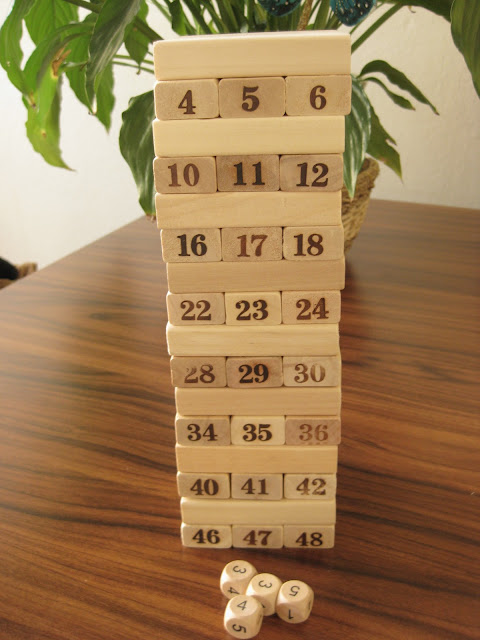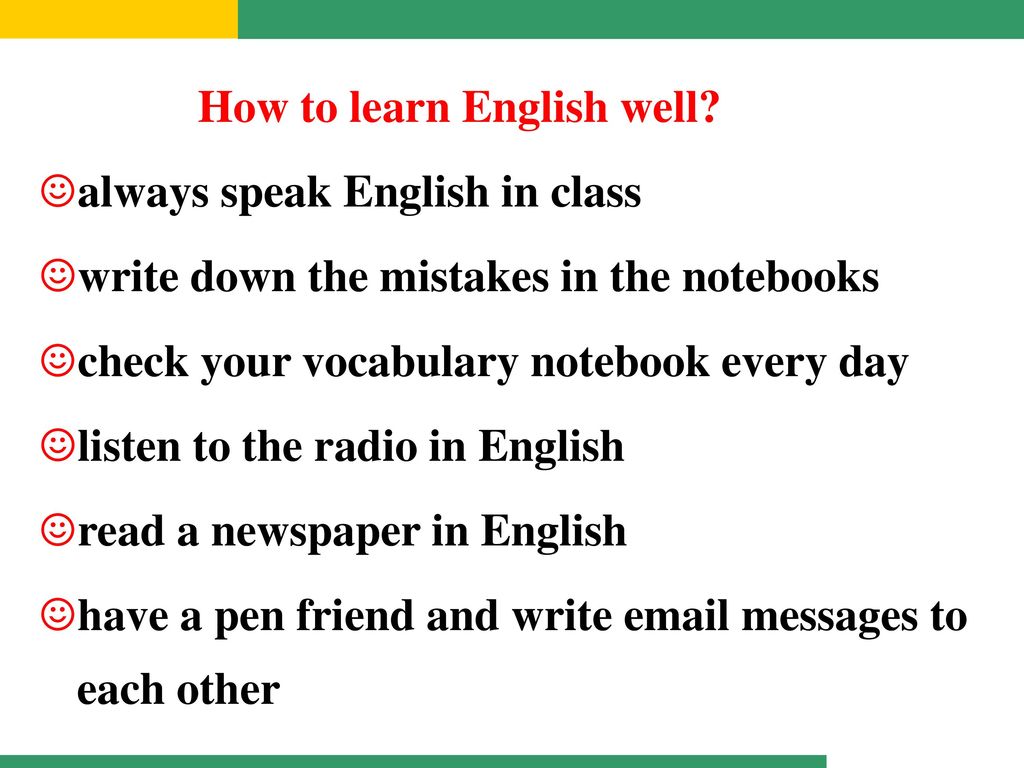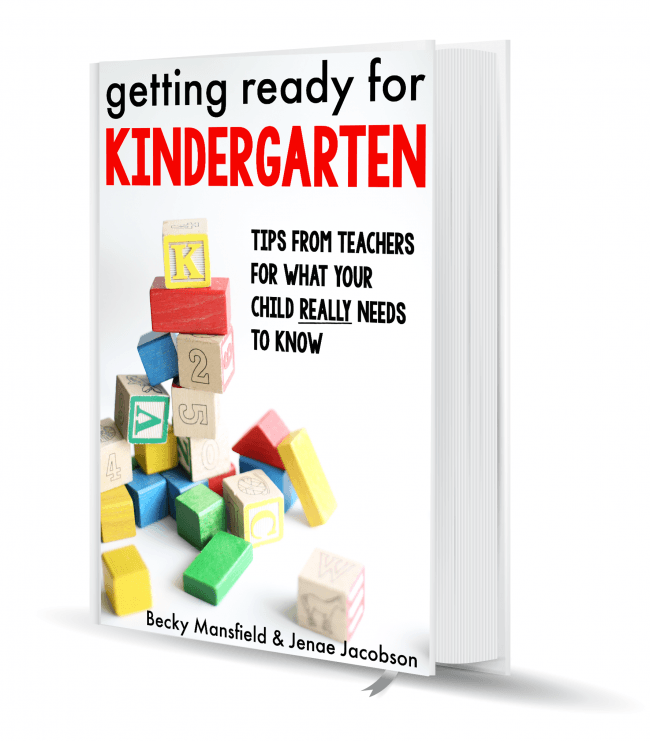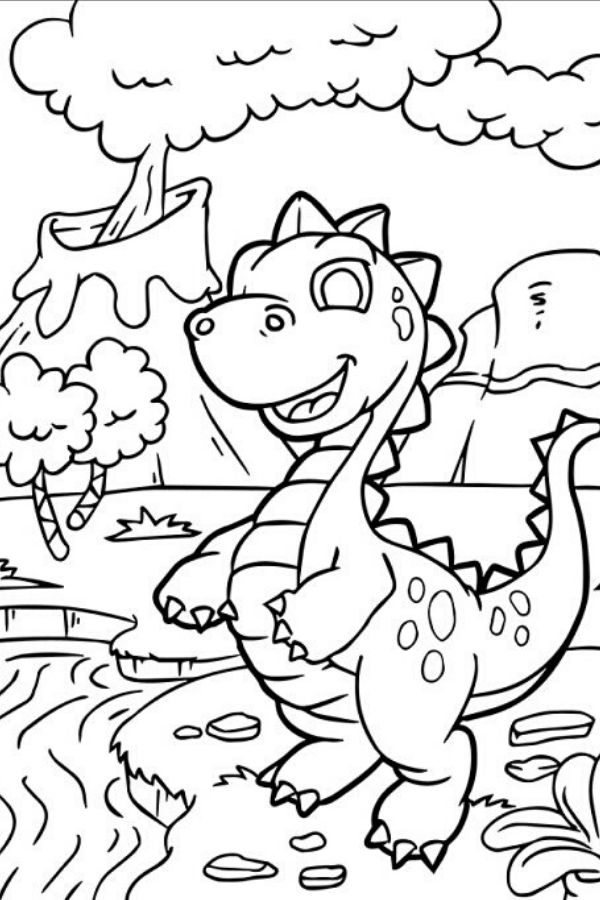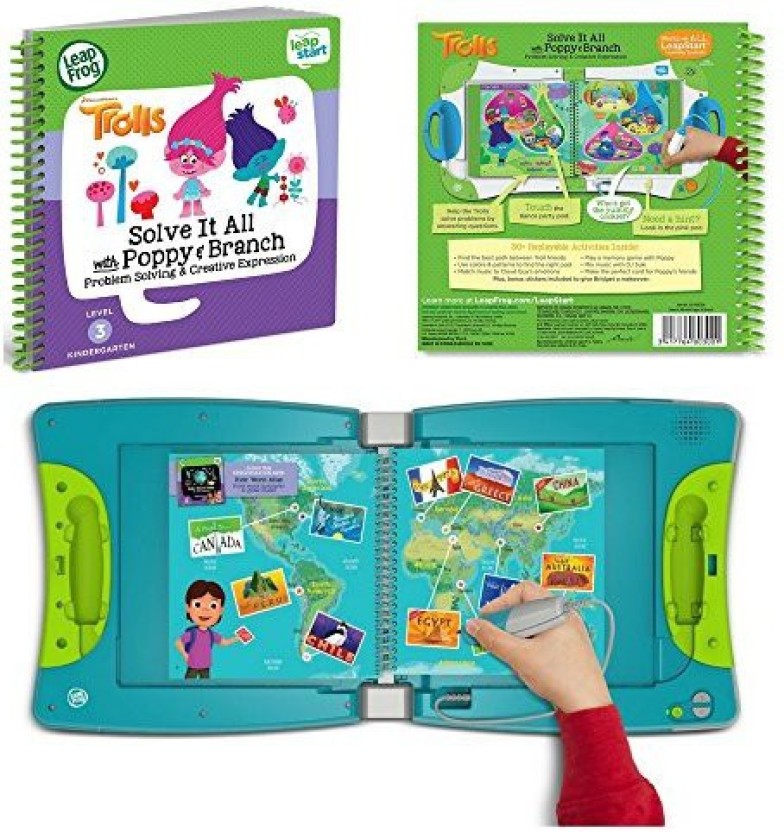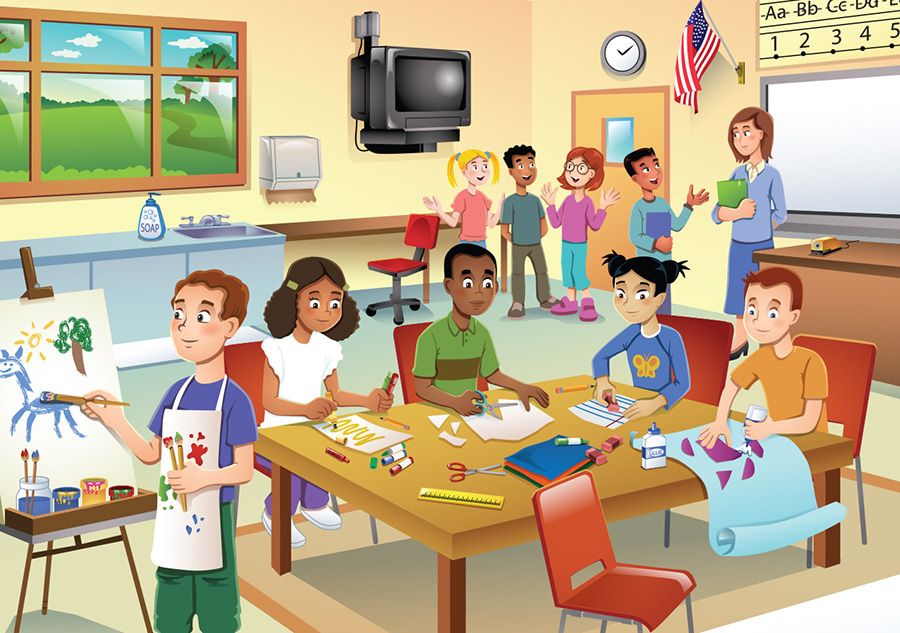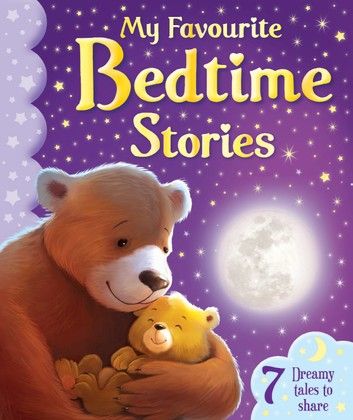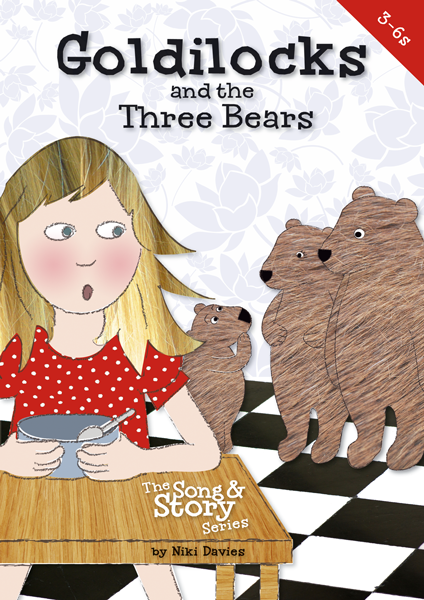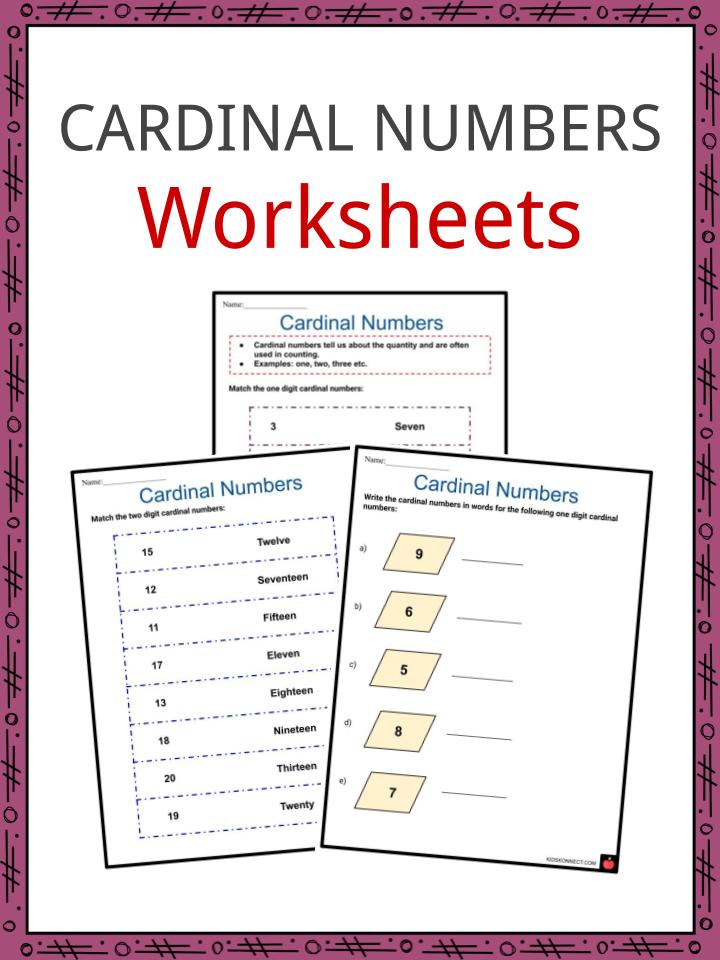Sight words jenga
Fountas and Pinnell 25 & 50 High Frequency Words Sight Word Jenga Game
Make reading and sight word practice fun with these language arts Jenga Game Cards! This set contains cards for FOUNTAS AND PINNELL 25 AND 50 SIGHT WORDS/HIGH FREQUENCY WORDS.
These cards are to be used with this color Jenga set: Lewo Wooden Stacking Board Games Building Blocks for Kids.
The game can be played with partners or a small group. Students take turns rolling the color dice. For whichever color they roll, they select a card with that color. They read the sight word aloud, and everyone in the group echos the word. Optional: have students write/spell the word on their answer sheets. The student who rolled the dice gets to move a Jenga block that matches the color of their card.
This downloadable resource comes with:
-Game instructions
-Student answer recording sheets
-Color-coded game cards
The set contains all sight words from the 25 word list and 50 word list from Fountas and Pinnell:
no, so, go, is, on, it, can, in, do, me, up, an, you, am, the, and, we, my, he, like, to, at, see, a, I, all, are, as, ball, be, boy, by, come, day, did, eat, for, get, girl, got, had, has, her, him, his, how, if, jump, look, man, mom, not, now, of, or, out, play, put, ran, read, run, sat, saw, say, she, sit, then, they, this, too, us, was, went, will, yes,
Bundle and save when you purchase this resource with all other Fountas and Pinnell Sight Word game sets:
Jenga Game Cards: Fountas and Pinnell High Frequency/Sight Words Bundle
Other Fountas and Pinnell Sight Word game sets for individual purchase:
Jenga Game Cards: Fountas and Pinnell 100 High Frequency/Sight Words Lists
Jenga Game Cards: Fountas and Pinnell 200 High Frequency/Sight Words Lists
Need Fry, Dolch, or Benchmark Advance High Frequency Words instead? Check out these game sets (available for individual purchase or in a bundle):
Jenga Game Cards for ELA/Reading: Fry Sight Words Bundle
Jenga Game Cards for ELA/Reading: Dolch Sight Words Bundle
Jenga Game Cards: Benchmark Advance High Frequency Words Bundle
See below for all available Jenga resources:
Blank Editable Cards (for any skill or subject):
Customize Your Own Editable Jenga Game Cards
Customize Your Own Editable Jenga Game Cards in Spanish
Customize Your Own Editable French Game Cards in French
Math Games:
Jenga Math Game Cards Growing Bundle for 1st Grade
Jenga Math Game Cards MEGA Growing Bundle for 1st Grade
Jenga Math Game Cards Growing Bundle for 2nd Grade
Jenga Math Game Cards MEGA Growing Bundle for 2nd Grade
Jenga Math Game Cards for 0-20 Addition Fact Practice
Jenga Math Game Cards for 0-20 Subtraction Fact Practice
Jenga Math Game Cards for 2 Digit Addition and Subtraction Practice
Jenga Math Game Cards for 3 Digit Addition and Subtraction Practice
Jenga Math Game Cards for Place Value
Jenga Math Game Cards for Telling Time
Jenga Math Game Cards for Counting Money
Jenga Math Game Cards for 1st Grade Shapes & Geometry
Jenga Math Game Cards for 2nd Grade Shapes & Geometry
Jenga Math Game Cards Bundle for Multiplication & Division Facts 0-12
Reading/Language Arts Games:
Jenga Language Arts Game Cards Growing Bundle for Grammar Practice
Jenga Language Arts Game Cards for Parts of Speech
Jenga Reading Game Cards Bundle for Dolch Sight Words
Jenga Reading Game Cards Bundle for Fry Sight Words
Jenga Game Cards Bundle for Fountas and Pinnell High Frequency/Sight Words
Jenga Game Cards Bundle for Benchmark Advance High Frequency Words
Seasonal Games:
Editable Back to School and End of the Year Jenga Games Bundle
“FALL”ing Jenga Autumn Themed Game Cards: ELA/Reading & Math Bundle
“Jenga Bells” Winter Holiday Game Cards Math & ELA Bundle
Valentine’s Day Jenga Math Game Cards: Bundle
St. Patrick’s Day Lucky Jenga Math Game Cards: 0-20 Addition & Subtraction
Want FREE storage labels for your Jenga cards? Find them here:
Jenga Game Cards Storage Labels
Only logged in customers who have purchased this product may leave a review.
Fountas and Pinnell 100 High Frequency Words Sight Word Jenga Game
Make reading and sight word practice fun with these language arts Jenga Game Cards! This set contains cards for FOUNTAS AND PINNELL 100 SIGHT WORDS/HIGH FREQUENCY WORDS.
These cards are to be used with this color Jenga set: Lewo Wooden Stacking Board Games Building Blocks for Kids.
The game can be played with partners or a small group. Students take turns rolling the color dice. For whichever color they roll, they select a card with that color. They read the sight word aloud, and everyone in the group echos the word. Optional: have students write/spell the word on their answer sheets. The student who rolled the dice gets to move a Jenga block that matches the color of their card.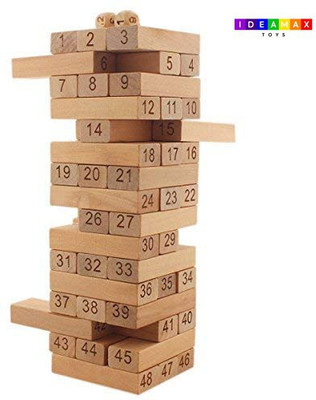
This downloadable resource comes with:
-Game instructions
-Student answer recording sheets
-Color-coded game cards
The set contains all sight words from the 100 word list from Fountas and Pinnell:
than, have, over, about, there, ride, back, any, don’t, after, into, said, I’m, just, that, been little one, big, make, with, came, before, five, away, two, their, your, four, what, who, mother, but, when, where, here, them, very, going, because, could, our, from, were, three, want, take, books, sleep, able, dad, good, love, bad, hide, help, much, give, almost, city, stay, today, dog, write, name, week, anything, top, new, something, home, room, paper, bus, down, under, rain, year, become, fast, door, can’t, end, hill, fun, tell, behind, know, sky, across, fish, use, both, world, why, let, time, cat, car, place
Bundle and save when you purchase this resource with all other Fountas and Pinnell Sight Word game sets:
Jenga Game Cards: Fountas and Pinnell High Frequency/Sight Words Bundle
Other Fountas and Pinnell Sight Word game sets for individual purchase:
Jenga Game Cards: Fountas and Pinnell 25 & 50 High Frequency/Sight Words Lists
Jenga Game Cards: Fountas and Pinnell 200 High Frequency/Sight Words Lists
Need Fry, Dolch, or Benchmark Advance High Frequency Words instead? Check out these game sets (available for individual purchase or in a bundle):
Jenga Game Cards for ELA/Reading: Fry Sight Words Bundle
Jenga Game Cards for ELA/Reading: Dolch Sight Words Bundle
Jenga Game Cards: Benchmark Advance High Frequency Words Bundle
See below for all available Jenga resources:
Blank Editable Cards (for any skill or subject):
Customize Your Own Editable Jenga Game Cards
Customize Your Own Editable Jenga Game Cards in Spanish
Customize Your Own Editable French Game Cards in French
Math Games:
Jenga Math Game Cards Growing Bundle for 1st Grade
Jenga Math Game Cards MEGA Growing Bundle for 1st Grade
Jenga Math Game Cards Growing Bundle for 2nd Grade
Jenga Math Game Cards MEGA Growing Bundle for 2nd Grade
Jenga Math Game Cards for 0-20 Addition Fact Practice
Jenga Math Game Cards for 0-20 Subtraction Fact Practice
Jenga Math Game Cards for 2 Digit Addition and Subtraction Practice
Jenga Math Game Cards for 3 Digit Addition and Subtraction Practice
Jenga Math Game Cards for Place Value
Jenga Math Game Cards for Telling Time
Jenga Math Game Cards for Counting Money
Jenga Math Game Cards for 1st Grade Shapes & Geometry
Jenga Math Game Cards for 2nd Grade Shapes & Geometry
Jenga Math Game Cards Bundle for Multiplication & Division Facts 0-12
Reading/Language Arts Games:
Jenga Language Arts Game Cards Growing Bundle for Grammar Practice
Jenga Language Arts Game Cards for Parts of Speech
Jenga Reading Game Cards Bundle for Dolch Sight Words
Jenga Reading Game Cards Bundle for Fry Sight Words
Jenga Game Cards Bundle for Fountas and Pinnell High Frequency/Sight Words
Jenga Game Cards Bundle for Benchmark Advance High Frequency Words
Seasonal Games:
Editable Back to School and End of the Year Jenga Games Bundle
“FALL”ing Jenga Autumn Themed Game Cards: ELA/Reading & Math Bundle
“Jenga Bells” Winter Holiday Game Cards Math & ELA Bundle
Valentine’s Day Jenga Math Game Cards: Bundle
St.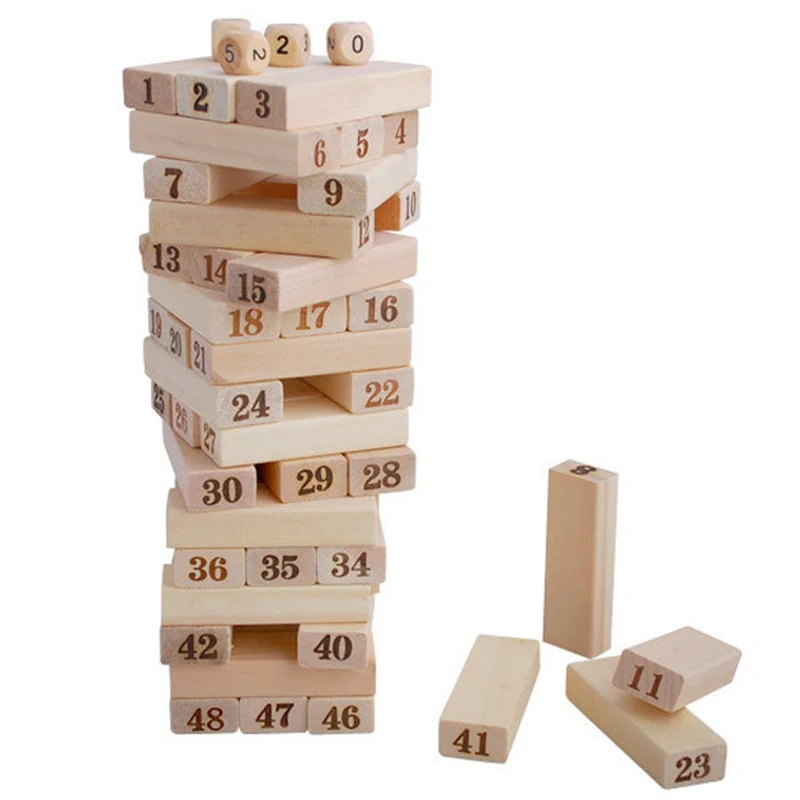 Patrick’s Day Lucky Jenga Math Game Cards: 0-20 Addition & Subtraction
Patrick’s Day Lucky Jenga Math Game Cards: 0-20 Addition & Subtraction
Want FREE storage labels for your Jenga cards? Find them here:
Jenga Game Cards Storage Labels
Only logged in customers who have purchased this product may leave a review.
How to play jenga with numbers and dice. Leaning Tower Board Game
How to win in Jenga?
In the age of computer games, when children and adults do not get out of their gadgets, it becomes a complete revelation for many that, in addition to many similar online strategies and shooters, there is an equally attractive world of board games that can captivate people of any age and gender.
The most important and most valuable thing that board games can give is communication, which people are deprived of by their own smartphones.
It's safe to say that board games such as Monopoly or Mafia can make you put your phones away and forget about them for long hours, especially if there is a cheerful company nearby!
In my opinion, perhaps the most provocative and absorbing game is the game Jenga, which has recently gained wide popularity.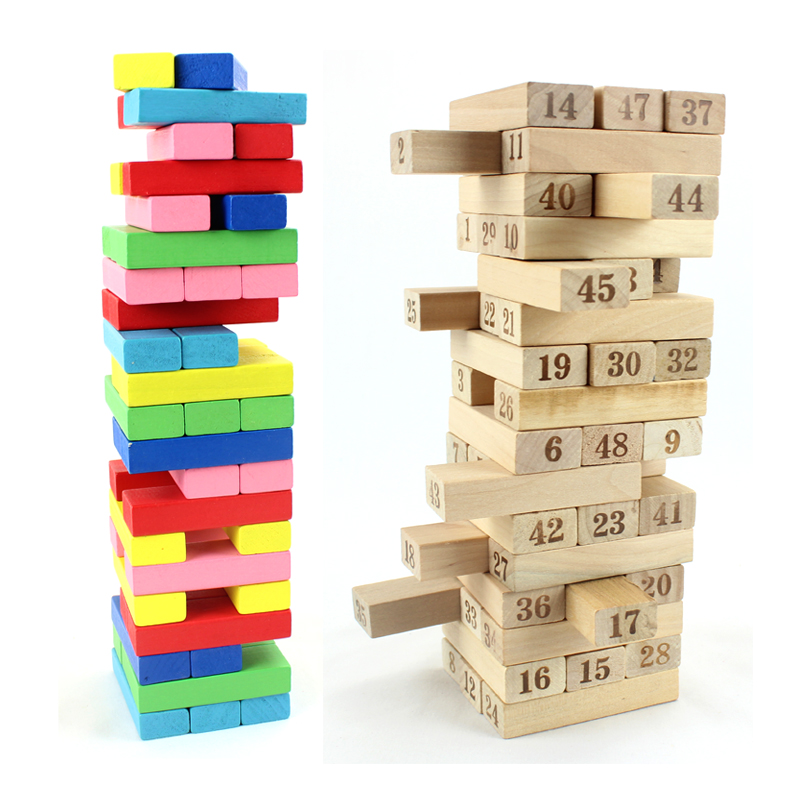 If someone is not in the know yet, then Jenga is a set of blocks that fold into a tower. Once, the seven-year-old daughter of our friends was presented with Jenga as a gift. At first, the child was not particularly happy with her, because he did not understand what to do with her. Adults came to help, and it was almost impossible to tear them away from the construction of the tower. Everyone was waiting for their turn to try their luck in building a "skyscraper" out of wooden blocks.
If someone is not in the know yet, then Jenga is a set of blocks that fold into a tower. Once, the seven-year-old daughter of our friends was presented with Jenga as a gift. At first, the child was not particularly happy with her, because he did not understand what to do with her. Adults came to help, and it was almost impossible to tear them away from the construction of the tower. Everyone was waiting for their turn to try their luck in building a "skyscraper" out of wooden blocks.
A bit of history
Jenga is a board game whose unusual name in Swahili means "build". The idea for the game comes from Leslie Scott, a British game designer of Tanzanian origin. As a child, she loved to collect pyramids from wooden cubes, which probably prompted her to create Jenga. The first batches of the game hit the shelves in London in 1983, and subsequently the rights to it were acquired by Hasbro.
The game gained wide popularity thanks to very simple rules of the game, understandable to both adults and children.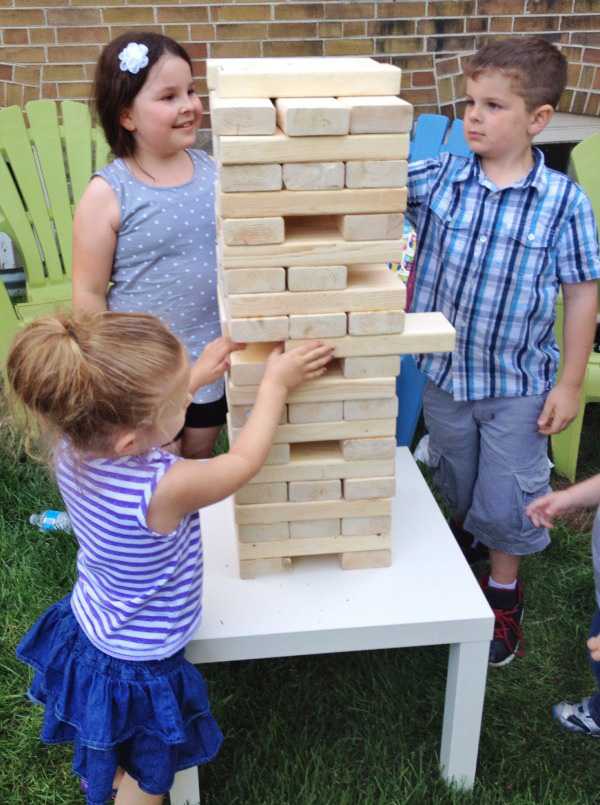 Folding the "floors" of the tower, three blocks in each, you need to fold the tower, then you need to shift the bars from the lower floors to the upper ones so that the tower does not fall. The loser is the one whose tower falls.
Folding the "floors" of the tower, three blocks in each, you need to fold the tower, then you need to shift the bars from the lower floors to the upper ones so that the tower does not fall. The loser is the one whose tower falls.
The path to victory
It would seem that everything is simple in this game, but even here there are tricks and ways to win. And here we would like to offer you our strategy.
1. Take your time!
Don't push yourself. Leslie Scott gives the following recommendation: “If you rush into Jenga, you will lose more than you will gain. Feel each brick and start with those that are easy to pull out. Leave the more immovable bars for later, when the weight of the tower is redistributed and they can be easily removed.
2. No strategy
Forget any strategy, just don't waste time on it. Why? Because each block is at least a little, but different in weight and size from the rest, so all the towers that you will collect before the start of the game will be different.
3. Higher is not better
Many people try to build the highest possible tower. Therein lies the error. The higher the tower, the more unstable it is.
4. Be dexterous
The rules state that you can use only one hand to pull the blocks out of the tower. But the hands get tired in tension, which can adversely affect the result. But the rules say nothing about the fact that hands cannot be changed. Also, nowhere is it said that you cannot balance the tower with your shoulder, using your hand as a brace.
5. Drive the tower
If it seems to you that there are no more available bricks left, it is quite possible to make them as such. How? For example, if the central block on the “floor” was removed, and two side blocks remained, pinch them from one edge (making them a diagonal in a square), and then remove one of them.
6. Distribute the Load Profitably
Placing blocks on top of a tower can give you an advantage over your opponent. You can make it harder for your opponent by stacking the bars on only one side. But be careful, if your opponent copes with your trap, you can already get into a "shaky" situation.
You can make it harder for your opponent by stacking the bars on only one side. But be careful, if your opponent copes with your trap, you can already get into a "shaky" situation.
From my own experience, the biggest difficulty in the game was to deal with laughter, which in most cases was the reason for the loss.
You can buy in our store and try to implement the success strategy in the game with your friends. Believe me, you are guaranteed a good mood!
This game is very simple and at the same time can bring a lot of pleasant minutes to both children and their parents. The number of players is practically unlimited: you can train alone and hold tournaments for 2, 3 and 10 people! First you need to buy a special set from 54 wooden blocks.
Rules of the game "Jenga"
First, a tower is built from a set of blocks on the table or on the floor. To do this, the blocks are stacked three in a row and the resulting layers are stacked on top of each other one across the other.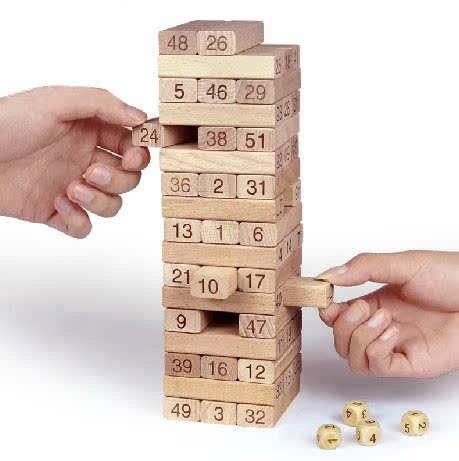 It turns out a tower of 18 levels. As a rule, a cardboard guide is included in the kit, which will allow you to level the tower for its exceptional flatness and verticality.
It turns out a tower of 18 levels. As a rule, a cardboard guide is included in the kit, which will allow you to level the tower for its exceptional flatness and verticality.
As soon as the tower is built and the turn order of the players is determined, you can start!
Each player, on their turn, tries to draw any block they think is free. This must be done using only one hand. You cannot work with both hands at the same time, but you can use your hands in turn if it is convenient. After the bar is released from the tower, it is placed on top of it in such a way as to continue building according to the rules: 3 bars per layer, each next layer across the previous one. You can not take the bars from the unfinished top layer and the next layer below it.
As soon as the block is placed, the move passes in turn to the next player and then around the circle. The player on whom the tower collapsed with a roar is considered the loser, and the game begins from the beginning.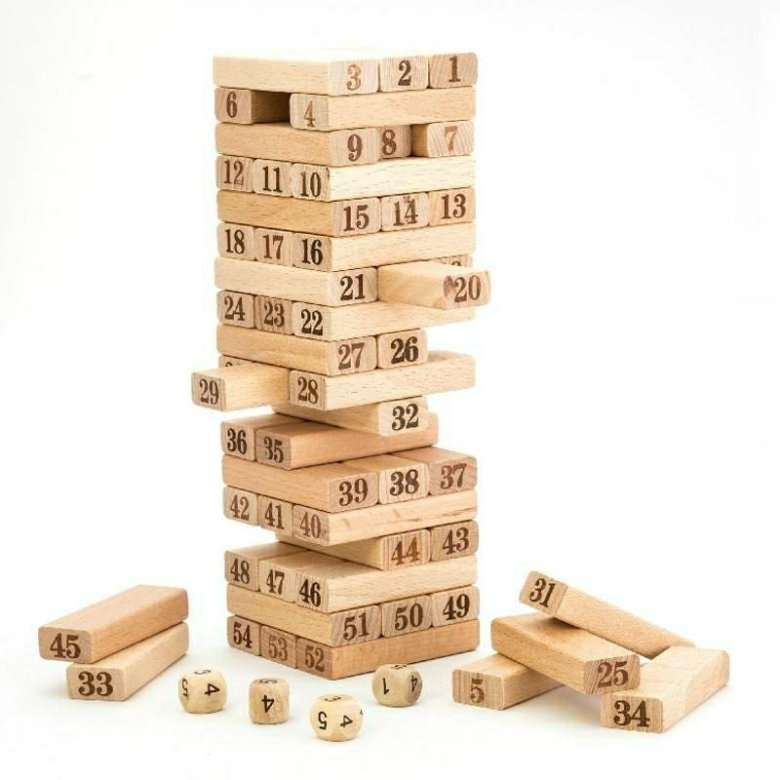 You can organize a knockout game.
You can organize a knockout game.
Tricks:
- First of all, you need to look for loose bars. They can be either on the edge, and then they can be “picked out” from the side, or in the center, then they must be pushed out with a finger from one side and then pulled out from the other;
- It is very important to pay attention to the slope of the tower: sometimes, after a new block is placed on one side of the tower, on the other side it becomes possible to pull out the block that was previously clamped;
- You can adjust "traps" for the following players: taking into account the slope of the tower, aggravate it by placing your block on the same side. But the main thing here is not to overdo it!
- Although you can't use both hands, you can use several fingers of one hand, for example, grab the block with your thumb and forefinger, and with the middle one carefully rest against the tower so that it does not fall. Well, and use your hands in turn.
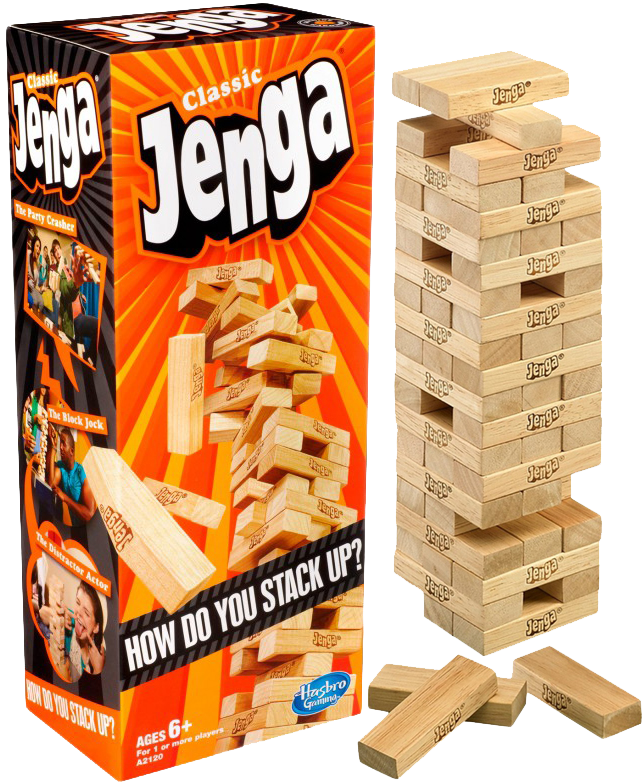
Jenga Video Game:
"Jenga" is an extremely popular, meditative and gambling game at the same time. In the process, the players act with bated breath, and losing marks the crash of a collapsed building.
Overview
The board game Jenga, also known as The Tower, is quite simple.
It is necessary to build a tower from wooden blocks, and then pull the sticks out of the tower and put them on the top floor. The structure will become more and more unstable until it collapses from careless movement or a breath of wind.
Basically, it is a bit like playing spillikins (with miniature utensils) or Mikado (using wooden skewers). The game takes an average of 5-10 minutes.
Who created
Jenga was invented by Tanzanian Englishwoman Lesley Scott in the early 1970s. Its ancestor was the game of blocks, which Leslie played as a child. The word "jenga" comes from the Swahili verb "build". The game is produced by one of the "daughters" of the company "Hasbro", replicas from the company "Igrotime" are popular in Russia.
At what age
You can play jenga from the moment when fine motor skills have developed sufficiently. You can build a tower for the first time at the age of five, although it is hardly worth an adult to compete with an impatient baby.
What's in the box
In the box you will find:
54 pieces of wood, easy to remove. Their size is about 8 centimeters in length, length and width are related as 3:1. Bamboo is used in the original, birch is more often used in Russian replicas;
cardboard sleeve for the construction of a flat tower, aka instructions.
Rules
In "Jenga" the rules are clear to both the preschooler and the grandmother. It is necessary to build a tower from the bars with the inscription "jenga", laying out three bricks in a row, on them - three bricks perpendicularly. There are 18 floors in total.
Next, you need to pull out one block at a time from the body and arrange it at the very top so that the skyscraper can stand.
You can touch the tower, try on, touch the bricks that you are going to pull out, but only with one hand. The main thing is not to drop. Dropped - lost. After each move, you need to wait 10 seconds, and only then pass the move on.
Sometimes "Jenga" is played using a grid not 3 by 3, but 4 by 4 bars. Then, in the process, a surprisingly intricate structure can turn out, the fall of which will be simply epoch-making.
There are more ways to play the tower. For example, buy a set with numbers on the dice and take out not random blocks, but the one whose number fell out on the dice.
Game mechanics
In "jenga" players have to show miracles of dexterity, to demonstrate the accuracy of movements and fine motor skills. Knowledge of physics and the ability to see an object in volume, calculate the balance will also come in handy.
Tricks and secrets
The rules of the game describe only the general principle of action, but experienced players know that there are subtleties:
Don't be in a hurry. The main thing is accuracy, so try on as much as you see fit;
The main thing is accuracy, so try on as much as you see fit;
Try how firmly the bricks sit. Some can be pulled out easily, some not. If the block does not want to go, do not pull it, otherwise you will almost certainly bring everything down;
Try to build a tower not higher, but more stable. This will make the game last longer. Or, on the contrary, make a shaky crown, hoping that the opponent will not be able to repeat your trick;
Pushing out the center blocks instead of the side blocks reduces the chance of collapse.
The game is unpredictable, because a mistake of a millimeter can cost a victory. The original Jenga even keeps the exact dimensions of the wooden blocks a secret. Allegedly, each brick is slightly different from the other, so that there is no exact balance and it is impossible to choose a uniquely winning strategy. However, the banal error of production gives the same effect.
Most intense moment
The most interesting thing begins when the tower is already quite skewed, and every movement can bring it down.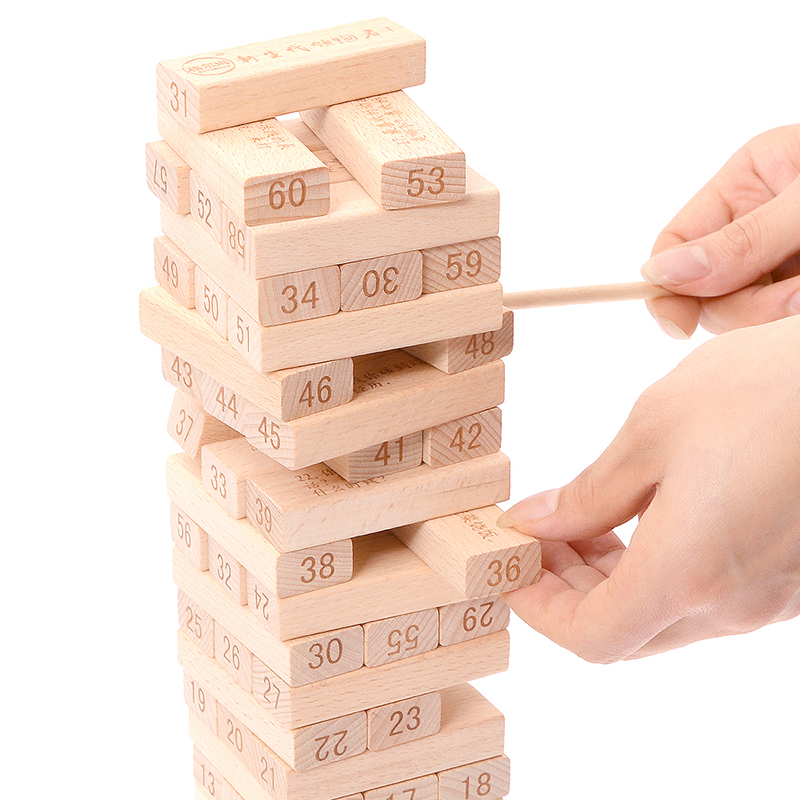 Will it come from the removed bar, which, as it turned out, held everything on itself. Or the building will collapse when the player has already pulled out the brick, put it on the roof and breathed a sigh of relief.
Will it come from the removed bar, which, as it turned out, held everything on itself. Or the building will collapse when the player has already pulled out the brick, put it on the roof and breathed a sigh of relief.
How to diversify the gameplay
When you get bored with the basic rules, bring in fresh ideas. It will become more fun and more difficult if:
- Write numbers on the ends of the pieces of wood, roll the dice and pull strictly dropped out;
- Write tasks on pieces of paper and take them before each move. For example, do everything with your left hand or sing a song in the process;
- Tasks or questions can be written directly on the boards;
- Do not build on, but dismantle the tower from below until there are so many holes in it that it will collapse.
How to increase interest
Just shifting wooden blocks quickly becomes boring. The way out is to come up with a prize.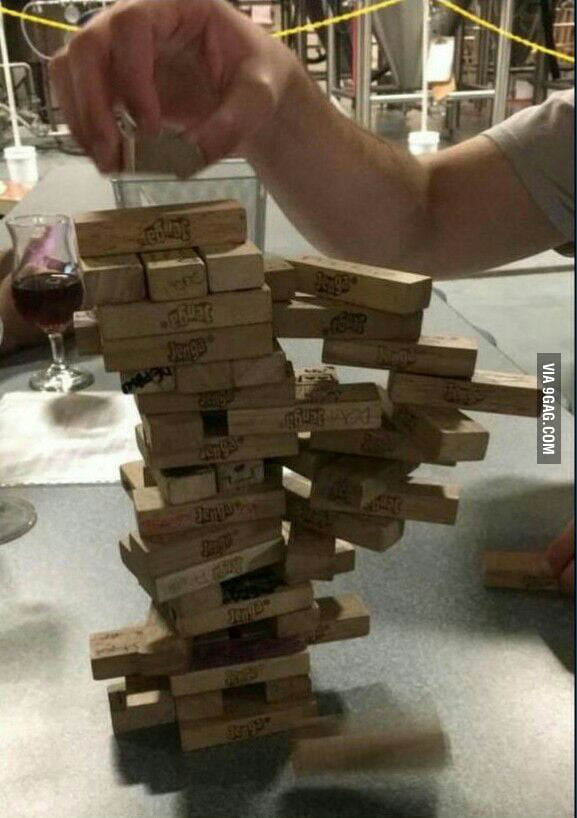 For example, desire. Some kind of large-scale - like the obligation to wash all the dishes after the party. Participants will fight with passion to the last brick!
For example, desire. Some kind of large-scale - like the obligation to wash all the dishes after the party. Participants will fight with passion to the last brick!
How else to use
With young children, you can use the Jenga as a construction set and build turret houses together, and then, optionally, take out the bricks as usual. Kids will be happy to take up new building material (more than environmentally friendly).
Who lost
Ai-i-i-ai, the falling tower has fallen! Who is guilty? Who wasn't careful enough? In whose turn did a fly fly past, and from the fluctuations of the air a catastrophe happened? This is where he lost.
Additional materials
Playing Jenga is more than just stacking blocks on top of each other. This is an exciting activity with a strong competitive moment. In addition, it can always be varied.
Popularity Secret
There are several secrets of the popularity of "Jenga":
- Very simple and clear rules, anyone can play it;
- It does not require much space other than a flat, hard surface such as the floor;
- Despite the transience of each game, it draws you in for hours;
- Consists of environmental materials, the details are pleasant to the touch;
- You can upgrade the kit instead of buying a new one;
- The best players are the most agile and the luckiest at the same time.
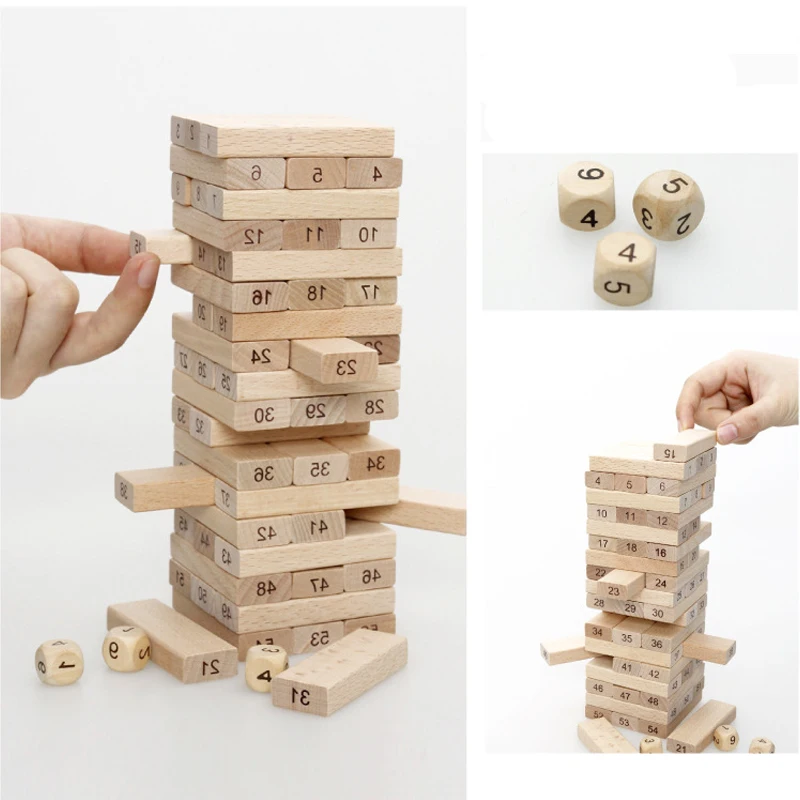
Benefits of playing the Tower regularly
The tower under construction for adults and children is a great shared activity. And for the party too.
Breaking down a block structure is good for concentration and fine motor skills. The player has to show everything that he is capable of.
The construction of the tower contributes to the development of spatial thinking. We are learning to imagine what exactly we get if we take out a part from one position and move it to another.
Other benefits
The game "jenga" is very exciting. It is simply impossible to break away - well, another five minutes, well, another game.
Jenga can be played by everyone from young to old. Which makes the desire to build a tower of wooden blocks an all-round family entertainment.
The number of participants is not limited - although if there are many of them, it is not a fact that the move will reach everyone. But whoever gets the chance will certainly try to concentrate with the top piece in their hands and not succumb to the "cheering" exclamations around like "Ruin it!".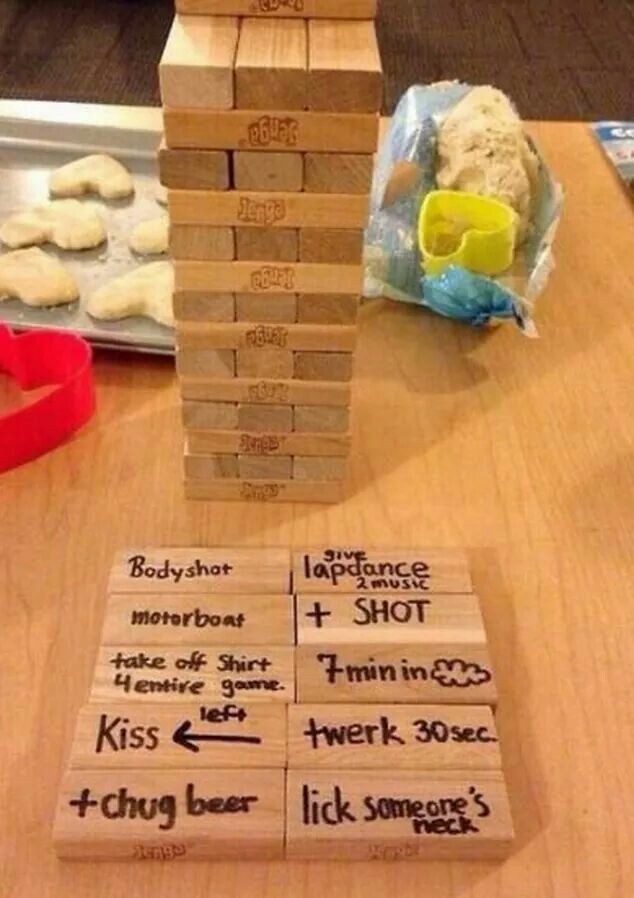
Durable set. Even if you have already played dozens of games, the appearance of the wooden parts will not change at all, they will not be wrinkled or rubbed like cards.
The height of all the bars is slightly different. This is not a bug - this is a feature to make the game even more unpredictable and interesting.
There is a whole line of games for the fans. For example, the one called "Django chairs".
Board game "Jenga" ("Tower") and its variations
History of appearance
The familiar Jenga was created by British board game designer Leslie Scott three decades ago. According to the author, it was created in the image and likeness of the game, behind which the whole Scott couple spent evenings in the distant seventies. Only then, instead of oblong wooden blocks, elements of the Takoradi children's designer, brought from Ghana, were used. Based on the same African fun, another game was created called Ta-Ka-Radi (Ta-Ka-Radi), very similar to Jenga. It appeared on the American market a few years earlier, but did not find such deafening popularity as Jenga.
It appeared on the American market a few years earlier, but did not find such deafening popularity as Jenga.
The game has a rather exotic name. "Jenga" is a Swahili word meaning "to build". The author of the game, Leslie Scott, is of British origin, but she was born in Tanzania and spent her entire childhood in African countries. Therefore, Leslie decided to pay tribute to her second native language, christening her new offspring with such an unusual name for Europeans.
Kit contents
The original Jenga consists of 54 oblong wooden blocks. The surface of each bar is carefully sanded, but not varnished or painted. This increases friction between structural elements and prevents the tower from crumbling. The dimensions of the block of the classic version of the game are 1.5x2.5x7.5 cm.
With the growing popularity of "Jenga", a lot of its "remakes" appeared on the market, the dimensions of the elements of which may differ from the progenitor, but the aspect ratio of the blocks is mostly preserved.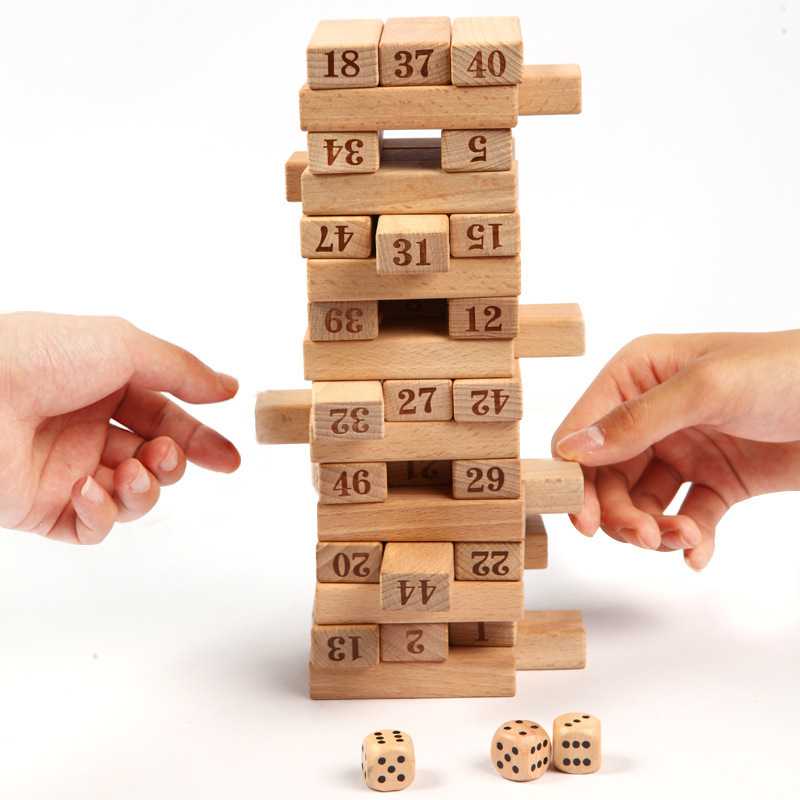
Ta Ka Radi vs. "Jenga"
These two games are very similar but have some significant differences. Ta-Ka-Radi uses only 51 rectangular blocks. As a result, the original tower is one floor lower than in Jenga, but the height of the structure is greater. The most important difference is how to place the bars. In "Ta-Ka-Radi" blocks are installed on the short side of the section with significant gaps between the elements of the same row. At the same time, in "Jenga" the bars lie close to each other on the long side of the section.
While Jenga comes in a paper bag, Ta-Ka-Radi comes in a printed natural cloth bag. The manufacturer also offers a choice of several types of fabrics from which the bag can be made, all colors in the spirit of Africa.
Game preparation
Before starting the round, the original tower must be level. You can level it using the box from the game itself. Some sets of "Jenga" come with a special plastic corner, which acts as a kind of level.![]() Initially, our building has 18 "floors" of 3 blocks each. The bars are laid on the long side. All elements must fit snugly together. In this case, the bars of each subsequent row are perpendicular to the blocks of the previous one.
Initially, our building has 18 "floors" of 3 blocks each. The bars are laid on the long side. All elements must fit snugly together. In this case, the bars of each subsequent row are perpendicular to the blocks of the previous one.
Rules and gameplay
Jenga is designed for two or more players. The principles of the game are very simple: each participant pulls out one block from an already standing structure and lays it perpendicular to the previous row. At the same time, the “penthouse” tier preceding the unfinished one remains inviolable. Also, you can not start laying blocks in a new level, leaving the top "floor" unfinished.
The block can be pulled out of the tower with only one hand. Beforehand, it is allowed to touch the elements and tap the ends of the bars, checking which of them is the most pliable. If at the same time something has moved, then the player must return all the affected blocks to their original position before the end of their turn.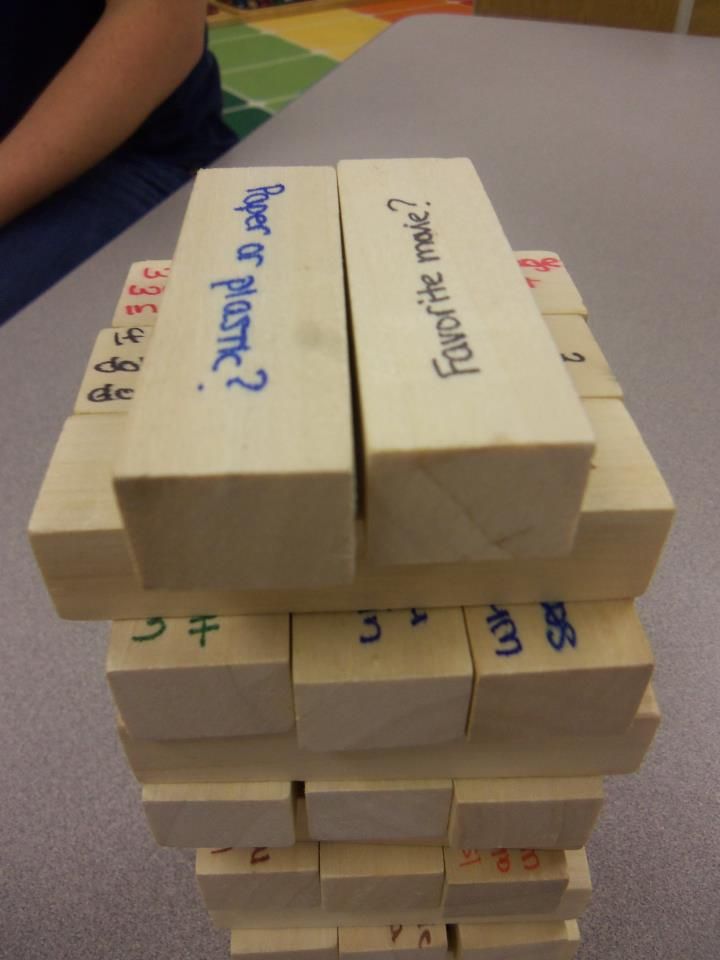
All participants take turns making their moves. The turn ends when the next player touches the tower or ten seconds after placing the pulled block.
Character of the game
The game trains fine motor skills and analytical skills. At the same time, it does not require the participants to develop a strategy and mental stress, so the gameplay is a relaxed fun pastime.
Varieties of the game
There are a great many varieties of Jengas on the board game market today, from small portable versions with tiny bars to huge copies that perform more of an advertising role than serving their intended purpose. Such a "tower boom" among the manufacturers of "board games" was undoubtedly due to the popularity that the game found among fans of such fun. According to the creator of the classic version of Jenga herself, about 50 million copies of the original game have been sold in the world.
"Jenga: Throw and Go" (Throw "n Go Jenga) - a game that was obtained by merging the good old "Jenga" and game dice.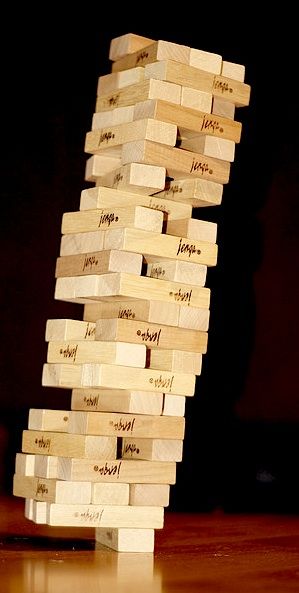 The elements of the classic set are painted in three different colors. The bones are marked with colors and words that say exactly where the block should be pulled out from (middle, top, bottom of the tower), as well as exactly how many blocks should be pulled out in one move. For example, after the first roll, you get the words "any two" on the top of the die. This means that you will have to "fight" with two bars, and not with one.
The elements of the classic set are painted in three different colors. The bones are marked with colors and words that say exactly where the block should be pulled out from (middle, top, bottom of the tower), as well as exactly how many blocks should be pulled out in one move. For example, after the first roll, you get the words "any two" on the top of the die. This means that you will have to "fight" with two bars, and not with one.
Throw the dice again, and the crimson face with the word "beginning" is the top one, which means that the first element is crimson, and it is located at the base of the structure. Then you throw a bone and get the word "middle" on a black background - you pull out a black bar from the middle of the tower.
Jenga Truth or Dare . The set consists of the usual number of blocks, two-thirds of which are colored orange and purple (colors may vary in different editions of the game). Orange bars are desires, purple bars are questions.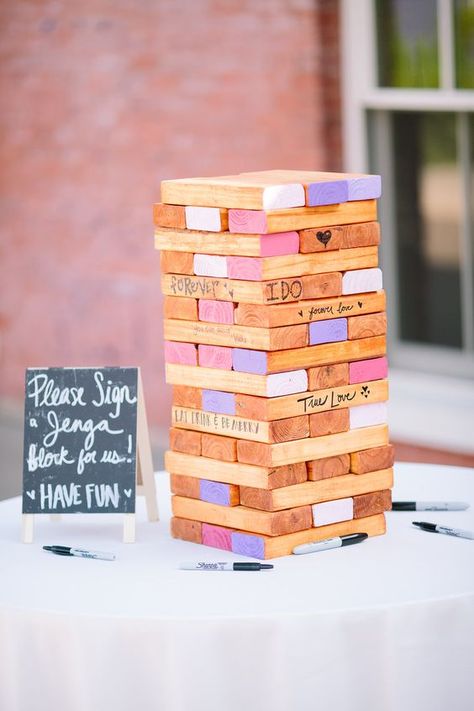 In this case, one third of the elements of the game remains unpainted. It is on these pristine bars that players are invited to write their own desires or questions. Then the game acquires individual characteristics and becomes one of a kind. In general, this variation is quite fun and aims to get the participants talking, and the gameplay is generously filled with fiction and eccentricity. Due to its nature, it is designed for players over 12 years old. Nevertheless, many rightly point out that this variety of "Jengi" is not suitable for children. The desires and questions proposed by the creators cannot be called crystal innocent. On the one hand, you may only need to sing a song or characterize one of the participants and the game (why not?). There are also more amusing statements, such as "sensual dance with a mop" and other similar inventions. Questions - from the category of tricky with a touch of the now popular "American humor".
In this case, one third of the elements of the game remains unpainted. It is on these pristine bars that players are invited to write their own desires or questions. Then the game acquires individual characteristics and becomes one of a kind. In general, this variation is quite fun and aims to get the participants talking, and the gameplay is generously filled with fiction and eccentricity. Due to its nature, it is designed for players over 12 years old. Nevertheless, many rightly point out that this variety of "Jengi" is not suitable for children. The desires and questions proposed by the creators cannot be called crystal innocent. On the one hand, you may only need to sing a song or characterize one of the participants and the game (why not?). There are also more amusing statements, such as "sensual dance with a mop" and other similar inventions. Questions - from the category of tricky with a touch of the now popular "American humor".
For kids, Jenga Girl Talk Edition is more suitable. is a much more harmless edition of the game. The blocks are colored in pink and crimson and filled with questions just like in the previous version. This could once be seen in children's questionnaires, which were then filled in by friends and classmates. Here you will find the traditional questions: “What is your most cherished desire?” or the more modern "Name your favorite website."
is a much more harmless edition of the game. The blocks are colored in pink and crimson and filled with questions just like in the previous version. This could once be seen in children's questionnaires, which were then filled in by friends and classmates. Here you will find the traditional questions: “What is your most cherished desire?” or the more modern "Name your favorite website."
Jenga Extreme . The elements of the game are not a rectangular parallelepiped, but a parallelogram. This adds a certain extreme to the gameplay and makes it possible to build tilted towers of completely bizarre shapes.
Las Vegas Casino Jenga - a completely unexpected combination of two absolutely different fun: "Jengi" and roulette! During the formation of the tower, players make bets. The set consists of 54 numbered red and black blocks, a betting board and 75 chips. Recommended for players aged 18 and over.
Jenga XXL is an enlarged version of the classic Jenga (although there are also much larger copies of the game).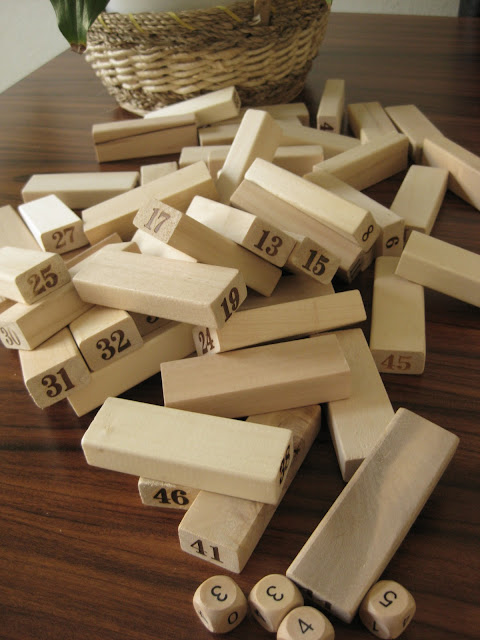 The size of each bar is about 45x22.5x7.5 cm. The kit comes with 50 elements (48 directly for the game and 2 "in reserve"). All blocks are made not of polished wood, but of painted plywood, so that during the fall the structure will not knock the players to death. The original tower has a height of 120 cm and can theoretically grow up to three and a half meters during the game! This variant of Jenga is especially good for outdoor play, and it goes great as a fun accompaniment to barbecues.
The size of each bar is about 45x22.5x7.5 cm. The kit comes with 50 elements (48 directly for the game and 2 "in reserve"). All blocks are made not of polished wood, but of painted plywood, so that during the fall the structure will not knock the players to death. The original tower has a height of 120 cm and can theoretically grow up to three and a half meters during the game! This variant of Jenga is especially good for outdoor play, and it goes great as a fun accompaniment to barbecues.
We have only briefly described some of the variations of this simple board game. There are also special editions. Particularly noteworthy is "Jenga: The Nightmare Before Christmas" (Jenga Nigthmare before Christmas) is a game designed in the spirit of a popular cartoon that appeared on screens more than twenty years ago. The blocks are colored black, purple and orange. Each of them has images of ghosts, funny, sad, cunning Jack Skelington mines and, of course, the name of the cartoon with its signature "Halloween" font.
In addition, there are many board games inspired by Jenga. In some, the rules of the original game are preserved, but the elements themselves are significantly modified. In particular, the snow-white set "Jenga Stack The Bones" looks very interesting. with blocks in the form of bones and a skull crowning the tower. Such a set can become not only a favorite game, but also an original interior decoration, which will also serve as a wonderful gift for lovers of various outlandish things. There are also similar sets on a more peaceful theme: with cats, bunnies, carrots, and so on.
As you can see, the good old "Jenga" does not stand still, but develops in accordance with the desires of modern users. The market is full of various options for our long-loved board game, among which you are sure to find the best "Tower" for yourself.
Elderberry jam: benefits and harms
Find out if we will meet. Dream interpretation of the house of the sun. How to correctly formulate a question in the process of divination
Rules of the jenga boom game in Russian.
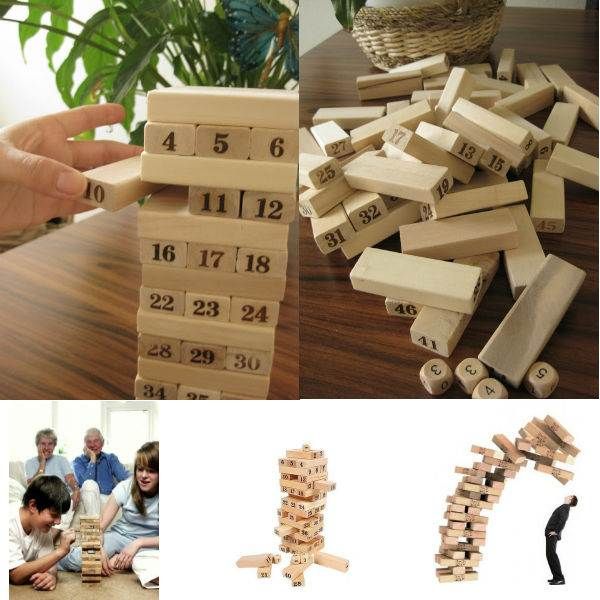 Board game jenga with numbers small
Board game jenga with numbers small Be the last player to place a block without knocking down the tower.
Game progress
Winner
The last player to remove a block from the tower structure without knocking it down wins. The player who knocked down the tower builds it for the next game!
Jenga (Jenga) or in Russian Tower is a simple and understandable game for all ages, both for kids and for their parents.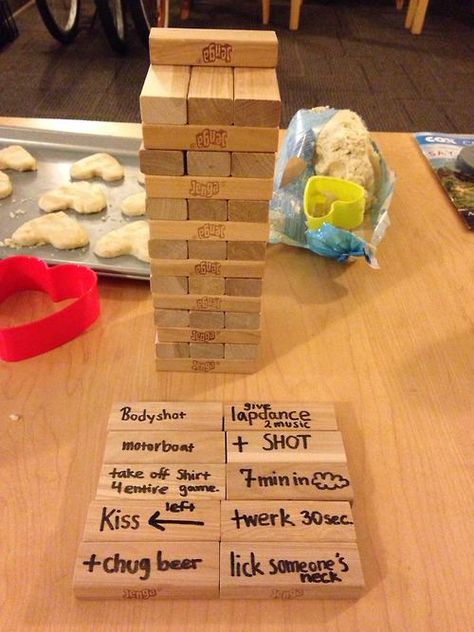 It was invented in England by the developer of board games - Leslie Scott. The first company to launch the game into mass production was one of Hasbro's divisions, namely Parker Brothers. The word Jenga means "Build" in Swahili.
It was invented in England by the developer of board games - Leslie Scott. The first company to launch the game into mass production was one of Hasbro's divisions, namely Parker Brothers. The word Jenga means "Build" in Swahili.
Jenga Tower rules
Jenga can be played by an unlimited number of players, but preferably two to five. Players take turns pulling blocks out of the tower and placing them on top of the tower. It is forbidden by the rules to get blocks from the top three platforms. Thanks to such manipulations, the tower becomes higher, but with each rearranged wand, it is more and more unstable.
To play Jenga, you need bars that are 3 times longer than wide and 1/2 the width high. For example: length = 75 mm, width = 25 mm, and height = 12.5 mm, respectively. In total, 54 wood blocks are needed in the game. A turret with 18 tiers is built from the blocks. Each tier has three sticks.
The game starts with building a tower. After it is built, the participants take turns starting the game by making moves. The right of the first move, according to the established tradition, belongs to the player who built the tower. The move in Jenga looks like this: the player takes a block from anywhere (except for the top three tiers) and puts it on top. It is forbidden to help yourself with the other hand. It is allowed to stop pulling a block from the tower if it seems to the player that when pulling it out, the tower will collapse. It is also allowed to push blocks to check which one is the most accessible. The move is considered completed if the tower has stood for 10 seconds after the removal of the block. The move is considered to have passed, also if the player whose turn to move touched the tower.
The right of the first move, according to the established tradition, belongs to the player who built the tower. The move in Jenga looks like this: the player takes a block from anywhere (except for the top three tiers) and puts it on top. It is forbidden to help yourself with the other hand. It is allowed to stop pulling a block from the tower if it seems to the player that when pulling it out, the tower will collapse. It is also allowed to push blocks to check which one is the most accessible. The move is considered completed if the tower has stood for 10 seconds after the removal of the block. The move is considered to have passed, also if the player whose turn to move touched the tower.
The game is over when the tower collapses. In the event that not the entire tower collapsed, but only some part of it, it is allowed to continue the game at the request of the participants.
Jenga Variations
Jenga Boom is a modified version of Jenga. The tower is being built on a platform, which is a "time bomb".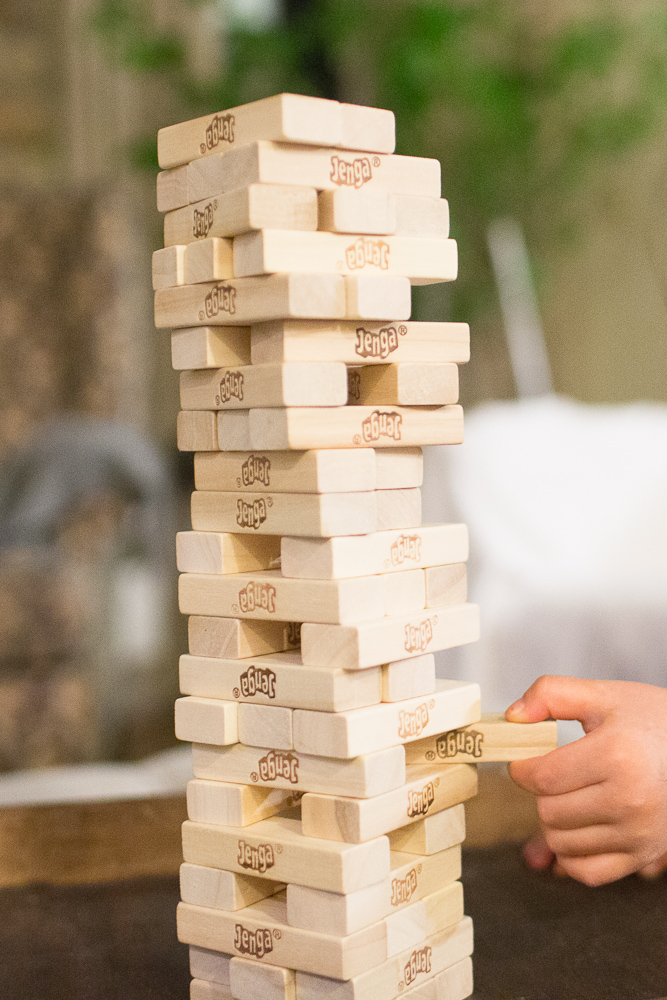 At the end of time, the "bomb" "explodes" and destroys the tower. The loser is the player whose turn the explosion occurs. So that the players do not delay the game waiting for an explosion, no more than twenty seconds are given for each move, the player who does not meet this time is eliminated.
At the end of time, the "bomb" "explodes" and destroys the tower. The loser is the player whose turn the explosion occurs. So that the players do not delay the game waiting for an explosion, no more than twenty seconds are given for each move, the player who does not meet this time is eliminated.
Jenga forfeits - each bar has a "fantas" written on it with a task.
Do-it-yourself Jenga
Factory set, for playing, fashionable to buy in almost any toy store. But for many, especially fathers of families, it seems that the set is too expensive. There is nothing easier, make Jenga yourself. You will need from materials: a wooden beam (its size is calculated based on the proportions given above). Required tools: Tape measure, caliper, wood saw, sandpaper with a grit size of 100 for primary processing and 320 for final). A brush, if you want to process the bars with paint or varnish.
For ease of cutting, tie the blanks tightly with adhesive tape. Then mark with a simple pencil the places where you will saw off the bars.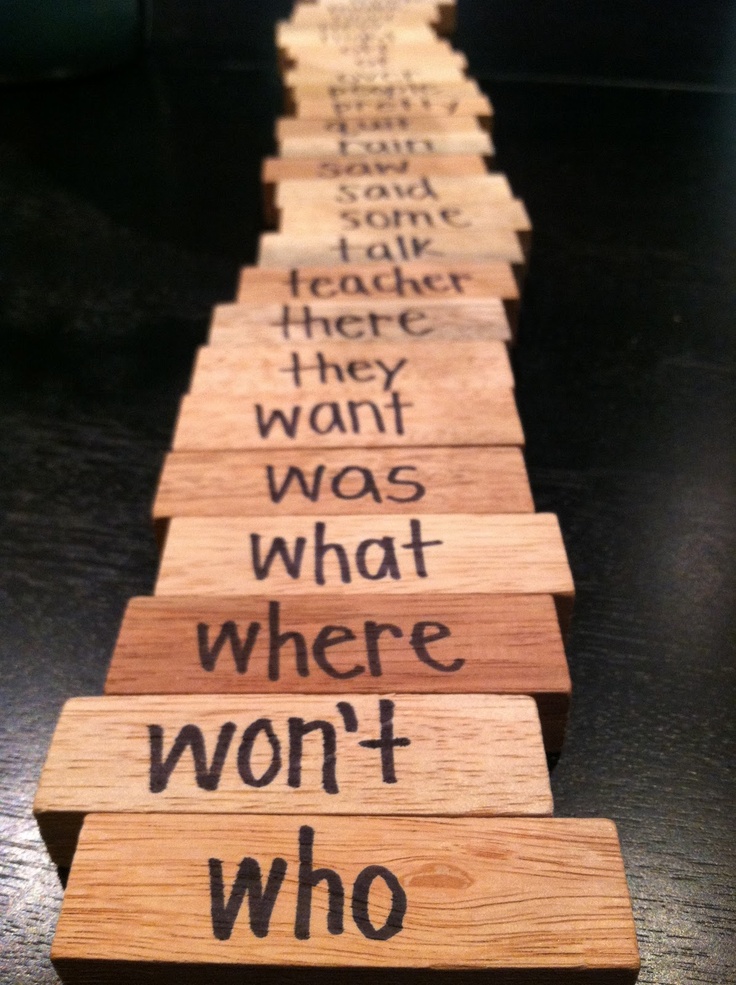 This will help you speed up the process and not make a mistake with the size. In total, you need 54 bars, but it’s better to make a margin.
This will help you speed up the process and not make a mistake with the size. In total, you need 54 bars, but it’s better to make a margin.
After sawing the blocks. It is necessary to process the blocks in order to avoid splinters and scratches from interaction with the untreated wood. Primary processing with coarse-grained sandpaper will also allow you to adjust small errors in size made during sawing. Use a caliper for more accurate measurements. These manipulations are necessary to ensure that the bars are as identical as possible. This will allow the tower to be more stable.
Re-processing will give the bars a smooth finish. The sticks will be nice to pick up and play with. In order for the bars to last longer and become even more beautiful, they can be varnished or painted.
Prepare a nice package to store the blocks. In it, they will not be lost and it will be easier to store them.
Oh no! I dropped the tower again!
Do you have strong nerves? Not? Pass by.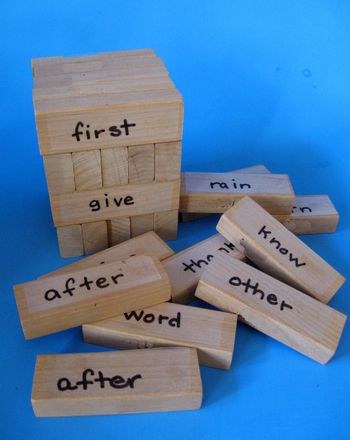 Are your hands shaking? Also past, next! But if you have a firm hand and nerves of steel, this seemingly uncomplicated game is for you.
Are your hands shaking? Also past, next! But if you have a firm hand and nerves of steel, this seemingly uncomplicated game is for you.
Jenga , also known as Gorodok (Russia), Leaning Tower of Pisa (Europe), Earthquake (Brazil), Brick house (Denmark stood out among the rest of Europe with its original name).
Rules are simple, you can say there are almost none.
First, a nice, flat tower of 18 floors is being built. During the game, it can increase more than twice. Do you have high enough ceilings? Each floor consists of three blocks laid close and parallel to each other. Blocks of each next floor are placed perpendicular to the blocks of the previous floor
Jenga. Your little Leaning Tower of Pisa
Jenga. Your little Leaning Tower of Pisa
Jenga. Your little Leaning Tower of Pisa
Jenga. Your little Leaning Tower of Pisa
According to the traditional rules, you can only touch the tower with one hand at a time.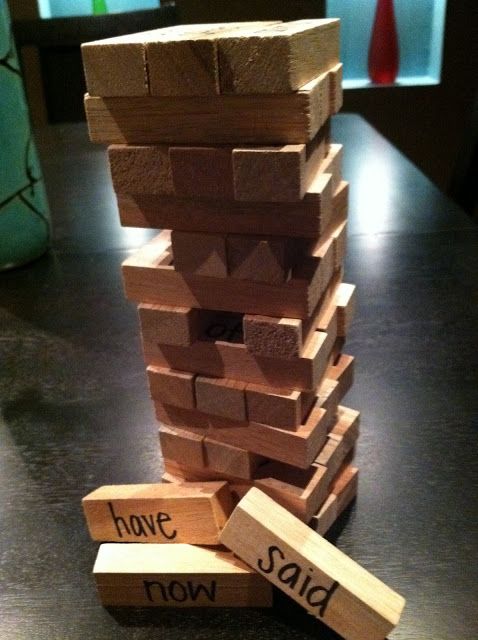
The game continues until the tower falls. It seems that in the first games it will happen quite quickly.
Now everything is also simple - the one who dropped the tower - lost, the one who made the previous move - won.
That's it, let's build the tower again to destroy it beautifully again!
Do you feel that there is little dynamics in the game? Play other, non-classic variants of Jenga :
- jenga with dice : more dice will be needed, and the blocks will need to be numbered. Before each block, we roll a die and pull out only the block with the corresponding number.
- Jenga Fanta : we are already writing various tasks on the blocks that correspond to your company and party, from "sing a song" and "tell a poem" to romantic evening ones - "kiss on the lips" (here you can safely turn to Captain Obviousness and Fanta-flirting for ideas. Shkolota , shoo from the post!). You are limited only by your imagination.
- colorful jenga : paint the blocks in different colors and play the same way with cubes or any other rules of pulling out blocks that you have invented game, game for iPhone.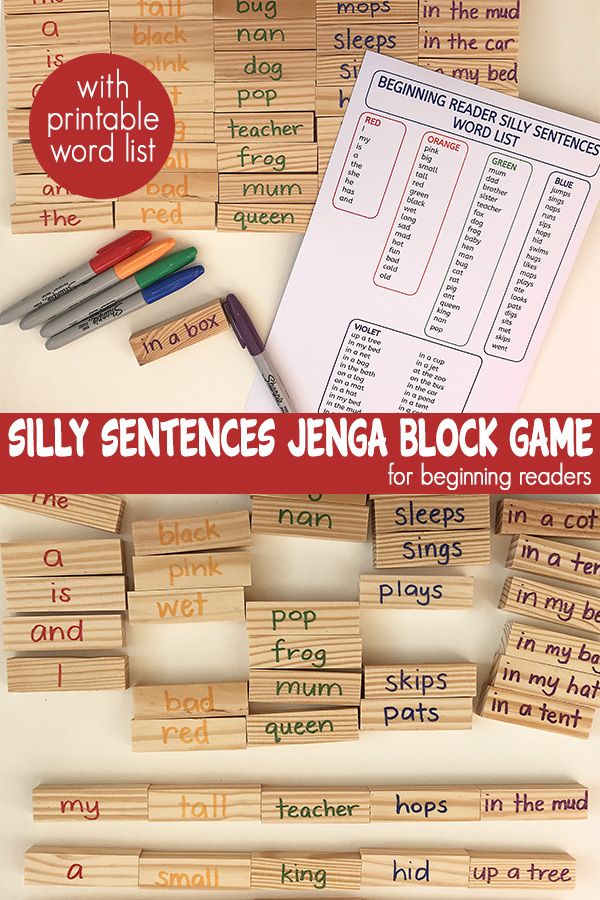 Only now for android I have not found it yet, I will be grateful for help in the search.
Only now for android I have not found it yet, I will be grateful for help in the search.
If you want to find out how agile and balanced you are, then Jenga Tower game is exactly what you need. If you are smart, you have well-developed manual dexterity, masterfully own a sense of balance, then it is for you. This game will captivate not only children, but also adults, be careful and attentive, and then you can build a tower twice as high as the original one.
Assemble the wooden block tower by removing the blocks from the lower "floors" and building the tower from above. The number of players is not limited, as well as their age.
Jenga tower rules
- Gather the players and select the "master" builder. He must build a tower of 18 floors. Lay out all the bars in front of you and start assembling the tower. The first floor consists of three blocks lying closely parallel to each other. Subsequent floors consist of three bars lying perpendicular to the existing ones.
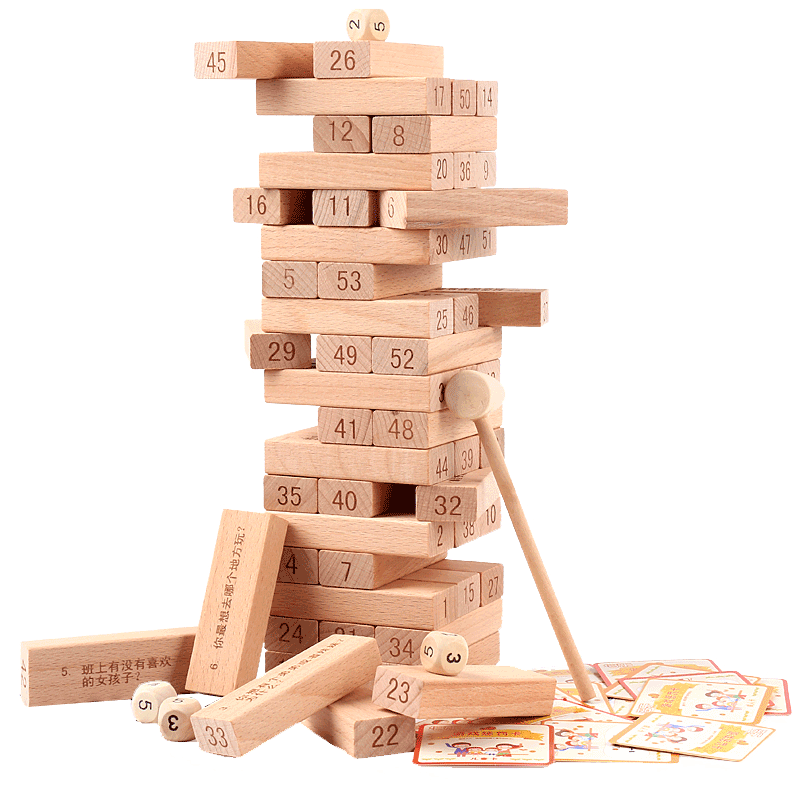 And so all the bars are laid out on top of each other.
And so all the bars are laid out on top of each other. - Level the tower so that Jenga's walls are level and the tower stands on its own.
- The one who built the tower goes first. He takes one block from any floor and puts it on the top row. The player following him takes out another block and puts it next to the block of the previous player. Attention: you can get the bars with only one hand. The bars can be touched to find one that moves freely and is easy to remove.
- Bars from the top row cannot be taken. A row is considered complete when there are three bars.
- The game continues until the tower collapses. The tower is considered to have fallen if any block has fallen, except for the one that the player is holding in his hand. The player who laid down his block last won, and the structure stood. If desired, the game can be continued if only a few blocks have fallen.
So, the basic rules are clear. But what if you have mastered this game and it doesn't seem so interesting anymore?
Then you can turn the Jenga tower. Write a task on each bar on the side and each player who gets it will have to complete it. Or you can number the bars according to the numbers on the dice and remove from the tower only the bar whose number fell on the die.
Write a task on each bar on the side and each player who gets it will have to complete it. Or you can number the bars according to the numbers on the dice and remove from the tower only the bar whose number fell on the die.
And these are just the simplest options. The rules of the game are only limited by your imagination. Get together with family or friends and play Jenga Falling Tower.
Hello friends! Blog "ShkolaLa" congratulates you on the New Year and welcomes you to the section "Home Laboratory"!
Be careful and careful! Today, tests are being carried out in our laboratory. Bold experimenters Artyom and Alexandra are testing. They have a Jenga board game on their lab bench. Have you heard of this one? Sometimes it is also called "The Tower". And game makers can be different. But our game is from Hasbro.
By the way, I have already told you a little about this toy. And today we will not only tell, but also show.
So what is Jenga? What are the rules of the game? What to do with these bricks? Find the answers to these and other questions in the video below.
I think that now everything has become quite clear. The game is really very interesting and is perfect as a gift not only for a child, but also for an adult who is still young at heart. And it is unlikely that you will be able to come up with something better for family leisure.
What about the age of the players? The description on the box says 6+. Just right for younger students!
We were especially interested in reviews of this board on the Internet. We found that for every 20 positive reviews, there is only one negative one. And even then, the negative is mainly associated with the quality of processing game bars. The thing is, they have to be smooth. And some comrades came across bars that were poorly processed, rough.
And in this case, it really won't be possible to pull them out of the tower. I dare to assume that people just simply got a fake. Since Hasbro has never let us down personally in this regard.
There are variations of Jenga.
For example, Jenga Boom.